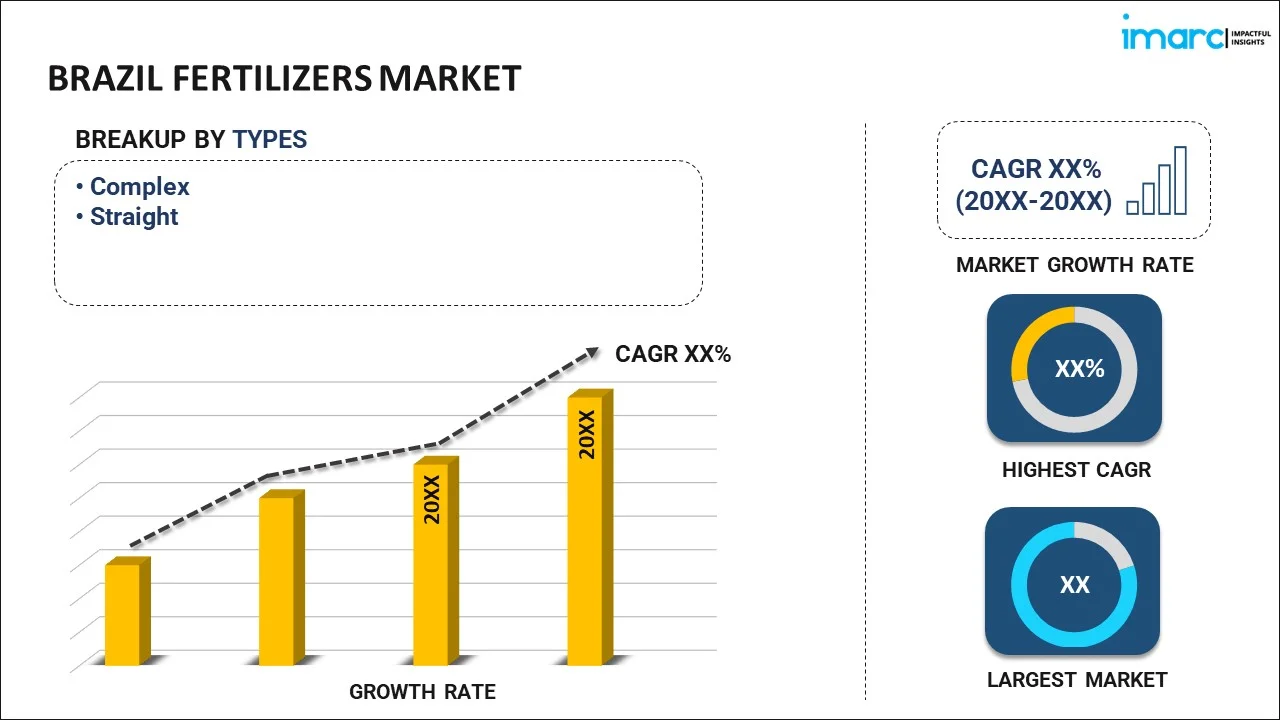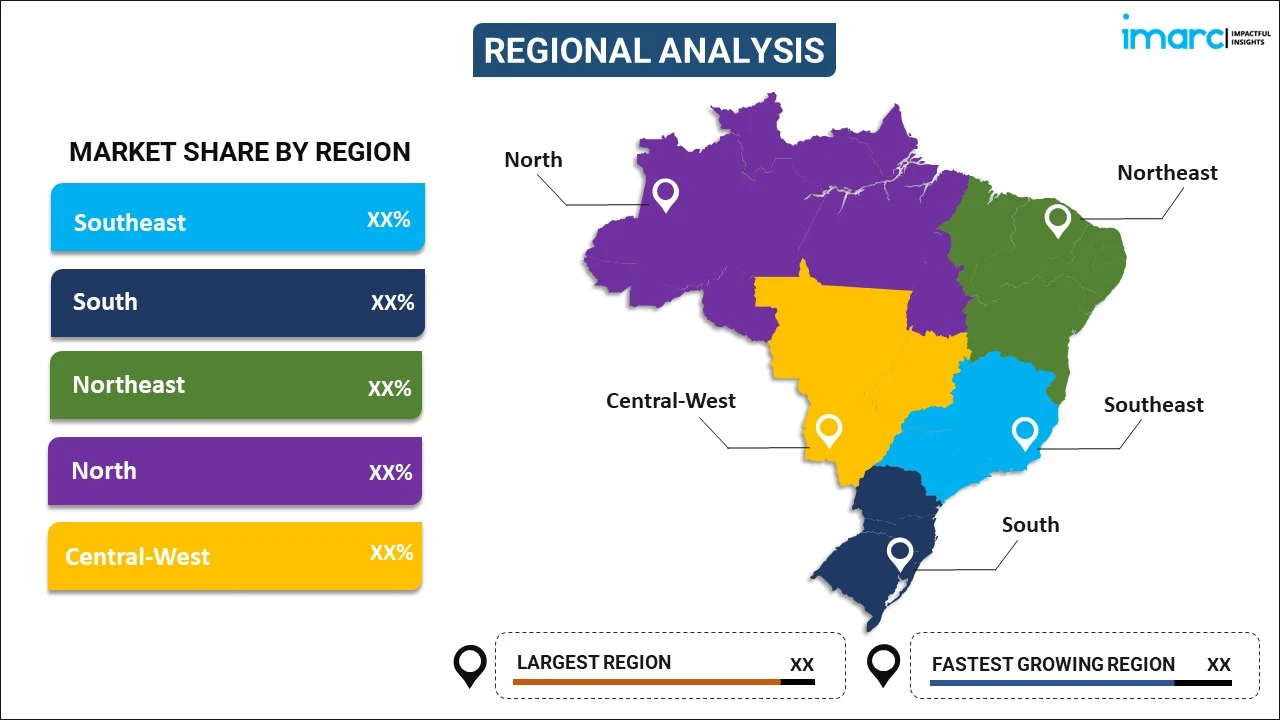
Brazil Fertilizers Market Report by Type (Complex, Straight), Form (Conventional, Specialty), Application (Fertigation, Foliar, Soil), Crop Type (Field Crops, Horticultural Crops, Turf and Ornamental), and Region 2025-2033
Market Overview:
Brazil fertilizers market size is projected to exhibit a growth rate (CAGR) of 6.84% during 2025-2033. The growing agricultural production, supportive government incentives and policies, expanding cultivating land, and the widespread adoption of organic fertilizers are increasing the market demand for high-quality fertilizers across the country.
|
Report Attribute
|
Key Statistics
|
|---|---|
|
Base Year
|
2024 |
|
Forecast Years
|
2025-2033
|
|
Historical Years
|
2019-2024
|
| Market Growth Rate (2025-2033) | 6.84% |
Fertilizers are essential substances or compounds introduced to the soil to supply plants with the necessary nutrients for optimal growth and yield. They are fundamentally formulated to enhance the natural fertility of the soil and bolster plant health by providing essential minerals and nutrients. Typically, fertilizers can be broadly categorized into two types: organic and inorganic. Organic fertilizers that are specifically derived from natural sources, including animal manure, compost, and bone meal, release nutrients slowly over time, ensuring sustained nourishment for plants. In contrast, inorganic fertilizers, often referred to as chemical or synthetic fertilizers, are industrially manufactured and supply nutrients promptly to plants. Key aspects to consider when using fertilizers include their nutrient composition, solubility, and release rate, which determine their effectiveness and suitability for various crops. One of the primary advantages of using fertilizers is their ability to augment crop yield, making them indispensable in modern agriculture. Moreover, they play a pivotal role in rectifying soil deficiencies, ensuring that plants receive a balanced diet for growth. As food demand escalates, the significance of fertilizers in ensuring crop productivity and food security remains paramount, thereby driving their importance in sustainable agriculture practices.
Brazil Fertilizers Market Trends:
Rising Agricultural Production
Brazil has solidified its position as a global agricultural powerhouse, particularly in the production of key crops such as soybeans, sugarcane, and corn. According to the Brazilian Institute of Geography and Statistics, agricultural activities experienced a growth of 15.1% from 2022 to 2023, positively impacting Brazil's GDP performance. This surge in agricultural activities has a direct impact on the fertilizer market, as farmers increasingly rely on fertilizers to boost crop yields and maintain soil health. The growing demand for higher crop productivity, driven by domestic consumption and export markets, has spurred greater use of fertilizers across Brazil’s vast agricultural sector. Moreover, fertilizers play a crucial role in maximizing output from arable land, ensuring that Brazil remains competitive on the global stage. As the country continues to expand its agricultural activities, particularly in high-demand crops like soybeans and corn, the need for fertilizers is expected to keep increasing, supporting the growth of the fertilizer industry in parallel with the agricultural sector’s expansion.
Supportive Government Incentives and Policies
The Brazilian government has taken proactive steps to support and strengthen the domestic fertilizer industry through initiatives like the National Fertilizer Plan (Plano Nacional de Fertilizantes). This strategic plan aims to reduce Brazil’s reliance on fertilizer imports by boosting domestic production and innovation. The government’s target is to lower the percentage of imported fertilizers to 45% by 2050, a goal that has sparked investment and technological advancements in local fertilizer manufacturing. Moreover, the plan encourages public and private sector participation in developing the country’s fertilizer production capabilities by offering incentives and creating a favorable regulatory environment. These efforts are aimed at reducing dependency on international suppliers and ensuring the sustainability and competitiveness of Brazil’s agricultural sector. The plan aligns with the country’s broader goals of increasing food security and agricultural self-sufficiency, making the fertilizer industry a key area of focus for future growth and development.
Expansion of Cultivated Land
Brazil’s agricultural sector continues to expand, where crops such as soybeans and corn are extensively grown. This significant increase in cultivated land is escalating the demand for fertilizers, as large-scale plantations require substantial amounts of nutrients to maintain soil fertility and ensure optimal crop growth. Additionally, the expansion is largely fueled by domestic and international demand for agricultural products, prompting farmers to intensify production. Moreover, fertilizers are essential for meeting the nutritional needs of crops on these vast plantations, helping to enhance yield and quality. As Brazil seeks to maintain its position as a global leader in agriculture, the increase in cultivated land directly correlates with higher fertilizer consumption. Besides, the Midwest, known for its agricultural productivity, has become a focal point for this growth, with fertilizer manufacturers increasingly targeting this region to supply the growing demand for efficient crop nutrition across Brazil.
Brazil Fertilizers Market Segmentation:
IMARC Group provides an analysis of the key trends in each segment of the Brazil fertilizers market report, along with forecasts at the country level for 2025-2033. Our report has categorized the market based on type, form, application mode, and crop type.
Type Insights:

- Complex
- Straight
- Micronutrients
- Nitrogenous
- Phosphatic
- Potassic
- Secondary Macronutrients
The report has provided a detailed breakup and analysis of the market based on the type. This includes complex and straight (micronutrients, nitrogenous, phosphatic, potassic, and secondary macronutrients).
Form Insights:
- Conventional
- Specialty
- CRF
- Liquid Fertilizer
- SRF
- Water Soluble
A detailed breakup and analysis of the market based on the form have also been provided in the report. This includes conventional and specialty (CRF, liquid fertilizer, SRF, and water soluble).
Application Mode Insights:
- Fertigation
- Foliar
- Soil
The report has provided a detailed breakup and analysis of the market based on the application mode. This includes fertigation, foliar, and soil.
Crop Type Insights:
- Field Crops
- Horticultural Crops
- Turf and Ornamental
A detailed breakup and analysis of the market based on the crop type have also been provided in the report. This includes field crops, horticultural crops, and turf and ornamental.
Regional Insights:

- Southeast
- South
- Northeast
- North
- Central-West
The report has also provided a comprehensive analysis of all the major regional markets, which include Southeast, South, Northeast, North, and Central-West.
Competitive Landscape:
The market research report has also provided a comprehensive analysis of the competitive landscape in the market. Competitive analysis such as market structure, key player positioning, top winning strategies, competitive dashboard, and company evaluation quadrant has been covered in the report. Also, detailed profiles of all major companies have been provided.
Brazil Fertilizers Market News:
- In August 2024, Petrobras, a Brazil-based company plans to invest R$6 Billion in the fertilizer sector over the next five years, which includes various projects currently under consideration. Out of this total, R$870 Million is specifically designated for restarting operations at the Araucária Nitrogenados SA (ANSA) fertilizer plant located in Parana, and the plant is anticipated to resume its activities in May 2025.
- On 13 March 2024, EuroChem inaugurated a cutting-edge phosphate fertilizer production facility in Serra do Salitre, Minas Gerais, Brazil. This new complex, which includes a phosphate mine and plant, represents an investment of nearly $1 Billion and was built in an impressive timeframe. It is expected to produce 1 Million Tonnes of advanced phosphate fertilizers annually, enhancing the stability of domestic phosphate fertilizer supplies for Brazilian farmers.
- In July 2024, Yara reached an agreement to transfer its NPK liquid fertilizer production and marketing assets in Brazil to FassAgro, a fertilizer company owned by the Brazilian group ENG. FassAgro, is a prominent company in the formulation and manufacturing of liquid fertilizers, encompassing NPK and foliar fertilizers. It operates under the ENG Group, which provides solutions for industrial operations within the sugar and energy industries.
Brazil Fertilizers Market Report Coverage:
| Report Features | Details |
|---|---|
| Base Year of the Analysis | 2024 |
| Historical Period | 2019-2024 |
| Forecast Period | 2025-2033 |
| Units | Million USD |
| Scope of the Report | Exploration of Historical Trends and Market Outlook, Industry Catalysts and Challenges, Segment-Wise Historical and Future Market Assessment:
|
| Types Covered |
|
| Forms Covered |
|
| Application Modes Covered | Fertigation, Foliar, Soil |
| Crop Types Covered | Field Crops, Horticultural Crops, Turf and Ornamental |
| Regions Covered | Southeast, South, Northeast, North, Central-West |
| Customization Scope | 10% Free Customization |
| Post-Sale Analyst Support | 10-12 Weeks |
| Delivery Format | PDF and Excel through Email (We can also provide the editable version of the report in PPT/Word format on special request) |
Key Questions Answered in This Report:
- How has the Brazil fertilizers market performed so far and how will it perform in the coming years?
- What is the breakup of the Brazil fertilizers market on the basis of type?
- What is the breakup of the Brazil fertilizers market on the basis of form?
- What is the breakup of the Brazil fertilizers market on the basis of application mode?
- What is the breakup of the Brazil fertilizers market on the basis of crop type?
- What are the various stages in the value chain of the Brazil fertilizers market?
- What are the key driving factors and challenges in the Brazil fertilizers?
- What is the structure of the Brazil fertilizers market and who are the key players?
- What is the degree of competition in the Brazil fertilizers market?
Key Benefits for Stakeholders:
- IMARC’s industry report offers a comprehensive quantitative analysis of various market segments, historical and current market trends, market forecasts, and dynamics of the Brazil fertilizers market from 2019-2033.
- The research report provides the latest information on the market drivers, challenges, and opportunities in the Brazil fertilizers market.
- Porter's five forces analysis assist stakeholders in assessing the impact of new entrants, competitive rivalry, supplier power, buyer power, and the threat of substitution. It helps stakeholders to analyze the level of competition within the Brazil fertilizers industry and its attractiveness.
- Competitive landscape allows stakeholders to understand their competitive environment and provides an insight into the current positions of key players in the market.
Need more help?
- Speak to our experienced analysts for insights on the current market scenarios.
- Include additional segments and countries to customize the report as per your requirement.
- Gain an unparalleled competitive advantage in your domain by understanding how to utilize the report and positively impacting your operations and revenue.
- For further assistance, please connect with our analysts.

 Inquire Before Buying
Inquire Before Buying
 Speak to an Analyst
Speak to an Analyst
 Request Brochure
Request Brochure
 Request Customization
Request Customization



.webp)




.webp)












